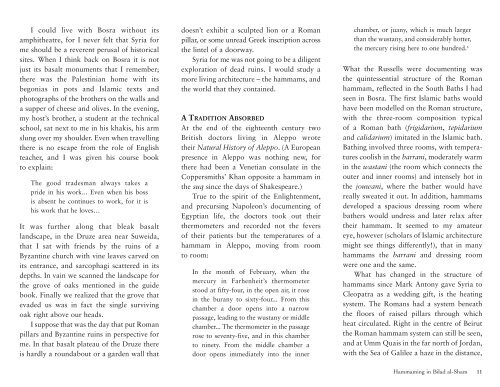Download an excerpt - Garnet Publishing
Download an excerpt - Garnet Publishing
Download an excerpt - Garnet Publishing
You also want an ePaper? Increase the reach of your titles
YUMPU automatically turns print PDFs into web optimized ePapers that Google loves.
I could live with Bosra without its<br />
amphitheatre, for I never felt that Syria for<br />
me should be a reverent perusal of historical<br />
sites. When I think back on Bosra it is not<br />
just its basalt monuments that I remember;<br />
there was the Palestini<strong>an</strong> home with its<br />
begonias in pots <strong>an</strong>d Islamic texts <strong>an</strong>d<br />
photographs of the brothers on the walls <strong>an</strong>d<br />
a supper of cheese <strong>an</strong>d olives. In the evening,<br />
my host’s brother, a student at the technical<br />
school, sat next to me in his khakis, his arm<br />
slung over my shoulder. Even when travelling<br />
there is no escape from the role of English<br />
teacher, <strong>an</strong>d I was given his course book<br />
to explain:<br />
The good tradesm<strong>an</strong> always takes a<br />
pride in his work... Even when his boss<br />
is absent he continues to work, for it is<br />
his work that he loves…<br />
It was further along that bleak basalt<br />
l<strong>an</strong>dscape, in the Druze area near Suweida,<br />
that I sat with friends by the ruins of a<br />
Byz<strong>an</strong>tine church with vine leaves carved on<br />
its entr<strong>an</strong>ce, <strong>an</strong>d sarcophagi scattered in its<br />
depths. In vain we sc<strong>an</strong>ned the l<strong>an</strong>dscape for<br />
the grove of oaks mentioned in the guide<br />
book. Finally we realized that the grove that<br />
evaded us was in fact the single surviving<br />
oak right above our heads.<br />
I suppose that was the day that put Rom<strong>an</strong><br />
pillars <strong>an</strong>d Byz<strong>an</strong>tine ruins in perspective for<br />
me. In that basalt plateau of the Druze there<br />
is hardly a roundabout or a garden wall that<br />
doesn’t exhibit a sculpted lion or a Rom<strong>an</strong><br />
pillar, or some unread Greek inscription across<br />
the lintel of a doorway.<br />
Syria for me was not going to be a diligent<br />
exploration of dead ruins. I would study a<br />
more living architecture – the hammams, <strong>an</strong>d<br />
the world that they contained.<br />
A TRADITION ABSORBED<br />
At the end of the eighteenth century two<br />
British doctors living in Aleppo wrote<br />
their Natural History of Aleppo. (A Europe<strong>an</strong><br />
presence in Aleppo was nothing new, for<br />
there had been a Veneti<strong>an</strong> consulate in the<br />
Coppersmiths’ Kh<strong>an</strong> opposite a hammam in<br />
the suq since the days of Shakespeare.)<br />
True to the spirit of the Enlightenment,<br />
<strong>an</strong>d precursing Napoleon’s documenting of<br />
Egypti<strong>an</strong> life, the doctors took out their<br />
thermo meters <strong>an</strong>d recorded not the fevers<br />
of their patients but the temperatures of a<br />
hammam in Aleppo, moving from room<br />
to room:<br />
In the month of February, when the<br />
mercury in Farhenheit’s thermometer<br />
stood at fifty-four, in the open air, it rose<br />
in the bur<strong>an</strong>y to sixty-four... From this<br />
chamber a door opens into a narrow<br />
passage, leading to the wust<strong>an</strong>y or middle<br />
chamber... The thermometer in the passage<br />
rose to seventy-five, <strong>an</strong>d in this chamber<br />
to ninety. From the middle chamber a<br />
door opens immediately into the inner<br />
chamber, or ju<strong>an</strong>y, which is much larger<br />
th<strong>an</strong> the wust<strong>an</strong>y, <strong>an</strong>d considerably hotter,<br />
the mercury rising here to one hundred. 6<br />
What the Russells were documenting was<br />
the quintessential structure of the Rom<strong>an</strong><br />
hammam, reflected in the South Baths I had<br />
seen in Bosra. The first Islamic baths would<br />
have been modelled on the Rom<strong>an</strong> structure,<br />
with the three-room composition typical<br />
of a Rom<strong>an</strong> bath (frigidarium, tepidarium<br />
<strong>an</strong>d calidarium) imitated in the Islamic bath.<br />
Bathing involved three rooms, with temperatures<br />
coolish in the barr<strong>an</strong>i, moderately warm<br />
in the wast<strong>an</strong>i (the room which connects the<br />
outer <strong>an</strong>d inner rooms) <strong>an</strong>d intensely hot in<br />
the jouw<strong>an</strong>i, where the bather would have<br />
really sweated it out. In addition, hammams<br />
developed a spacious dressing room where<br />
bathers would undress <strong>an</strong>d later relax after<br />
their hammam. It seemed to my amateur<br />
eye, however (scholars of Islamic architecture<br />
might see things differently!), that in m<strong>an</strong>y<br />
hammams the barr<strong>an</strong>i <strong>an</strong>d dressing room<br />
were one <strong>an</strong>d the same.<br />
What has ch<strong>an</strong>ged in the structure of<br />
hammams since Mark Antony gave Syria to<br />
Cleopatra as a wedding gift, is the heating<br />
system. The Rom<strong>an</strong>s had a system beneath<br />
the floors of raised pillars through which<br />
heat circulated. Right in the centre of Beirut<br />
the Rom<strong>an</strong> hammam system c<strong>an</strong> still be seen,<br />
<strong>an</strong>d at Umm Quais in the far north of Jord<strong>an</strong>,<br />
with the Sea of Galilee a haze in the dist<strong>an</strong>ce,<br />
Hammaming in Bilad al-Sham 11


